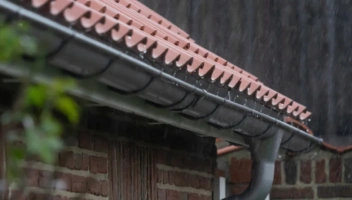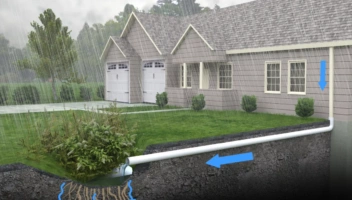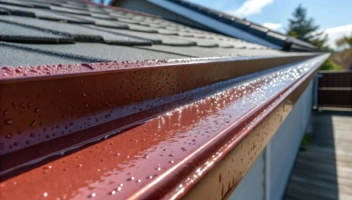Gutter guards can be an effective part of any rain gutter system as they work to filter out debris, leaves, and shingle grit, preventing clogs and protecting your home from damage.
If you plan on installing gutter guards on your own, there are a number of considerations to be aware of. From prepping your gutters properly to installing the gutter guard correctly, it’s important to do the job right to avoid problems down the road.
Here are some mistakes to avoid when doing a DIY gutter guard installation.
In this article, we’ll discuss:
- What Are Gutter Guards?
- Types of Gutter Guards
- 5 Steps for Installing Gutter Guards
- Tips and Precautions While Installing Gutter Guards
- Leave Installation to the Pros at LeafFilter Gutter Protection
- Frequently Asked Questions
What Are Gutter Guards?
Gutter guards — also known as leaf guards — are a type of cover that goes over or inside your gutters. They are usually made from a mesh material to keep out debris, deter nesting animals, and keep rainwater running smoothly.
Without properly fitted gutter guards, your gutters can accumulate leaves, pine needles, twigs, and other debris and cause clogs. From there, your clogged gutters can lead to larger issues like water damage from overflow, pest infestations from standing water, or even ice dams if you live in a colder climate.
Types of Gutter Guards
Each type of gutter guard has unique features and benefits, from ease of installation to effectiveness at keeping out small or large debris. The best gutter guards, however, are those that work best with your home’s design and your area’s climate.
Screen
Screen gutter guards are very simple: flat sheets perforated with holes that attach on top of your gutter system. They slide on top of your gutters and are held in place with clips or screws, making installation easy for the average DIYer.
These basic gutter screens don’t always block out smaller debris like pine needles, however, and you’ll still need to do a full gutter cleaning every year.
Mesh
Mesh gutter guards are similar to screen guards but are made with finer holes to keep out smaller debris while still allowing for great water flow. You can choose between plastic or metal for your mesh gutter guards, mostly depending on your budget and aesthetics.
A DIYer can easily install mesh guards that snap onto their gutters, while others may want to hire a professional to install mesh guards that require screwing into the gutter.
Micro-Mesh
An even more finely woven screen guard is the micro-mesh gutter guard. These are ideal for areas where you commonly combat pollen, pine needles, and dirt in your gutters. This type of gutter guard is better installed by a professional rather than a homeowner.
The high level of filtration in micro-mesh guards may mean less free flow of water, so be mindful about installing them in high-flow areas like roof valleys.
Foam
Foam gutter guards use a different type of approach to keeping debris out of your gutter system by inserting long blocks of foam directly into your gutters. They’re inexpensive, lightweight, and easy to install.
Foam gutter guards can, however, be a breeding ground for seeds to germinate and will quickly break down in the sun, so they shouldn’t be used long-term. Cleaning out your foam gutter guards means completely replacing them, so they’re a good temporary option when looking for other solutions.
Brush
Brush gutter guards are similar to foam guards, using a blocking and filtering material that any DIYer can easily place directly inside a gutter system. They look like large pipe cleaners with bristles to catch debris while rainwater flows through. But this also means that the guard itself traps the debris instead of shedding or blocking it, so you’d need to pull out the entire brush and clean that off regularly to keep your gutter system from clogging.
Reverse-Curve
Also known as surface-tension guards, the reverse-curve gutter guards use an aluminum or plastic hood (or cap with a curved edge) that leaves a space between the guard and the gutter lip. Surface tension, which holds drops of water together, allows rainwater to flow down the hood and over the curve, landing in the gutter, while debris falls off to the ground below. Your roof shingles would need to be lifted to install the guards correctly, so these guards should only be installed by a professional.
5 Steps for Installing Gutter Guards
If you’re taking the DIY approach to gutter guard installation as a home improvement project, make sure you follow each of these steps to make the most of your new gutter guards.
-
Find Stable Footing
Make sure you place your ladder on a solid, level surface by using either a platform or ladder stabilizers. If possible, try to use a step ladder for additional stability. If you’re installing gutter guards on a two-story home, then you may need an extension ladder.
-
Prep the Gutters
Before installing any gutter protection systems, make sure your gutters are aligned well so that they slope towards your downspouts and encourage the proper flow of rainwater. They should also be fully attached to your fascia and not loose or wobbly.
-
Clean and Test Your Gutters
Remove any leaves, pine needles, twigs, and other debris from your gutters so that you’re starting with a clean slate. Use a hose to fully flush out your gutters and check the water flow from your downspouts. You can also check your gutters for any holes or leaks you’ll need to repair.
-
Measure
Use your tape measure to get accurate measurements of all your gutters — you’ll need to know the length, width, and depth, depending on the type of guard you’re installing. For the width, measure from the outer edge of your gutter to the closest edge of the roofing.
-
Follow Manufacturer Instructions
Every type of gutter guard has its own specific installation instructions. Always read through the manufacturer’s instructions to be sure you’re properly handling the materials to avoid damaging your gutters.
Precautions While Installing Gutter Guards
If you are opting to install your own gutter guards, here are some common mistakes to avoid.
Nailing into the Roof
Some gutter guards will require you to nail the system into your roof. We can’t stress enough how bad this is for your roof. This will create damage on your roof and your shingles will no longer do their job at protecting your home properly from the intrusion of water. As soon as you poke a hole in your roof, you will have reduced its effectiveness in maintaining that barrier.
Lifting the Shingles
Other gutter guard systems require installation under your first row of shingles, but installing gutter guards under shingles is unwise. This can break your roof’s water barrier, leading to costly water and wind damage down the road.
Buying the Wrong Size
Gutter guards are rarely one size fits all. While most come in 5– or 6-inch sizes, it’s important to measure your gutters to get a proper fit.
Handle Gutters with Care
We’ve seen far too many homeowners try to install gutter guards and end up damaging their gutter system in the process. Try not to change the pitch of the gutter, which can reduce the effectiveness of your rain flow protection. You’ll also want to ensure the gutter hangers are secured.
Installing an Ineffective Gutter Guard
Think that wire mesh is going to provide total debris protection? Choosing the right gutter guard for your home is extremely important. Systems with large holes, gaps, and openings will only let debris in, while many do-it-yourself systems are flimsy and not backed by warranties. These types of systems prove to be only a temporary solution to a permanent problem. You’ll likely have to climb the ladder multiple times a year to clean out what your gutter guard has let in.
[lf_quote_snippet quote=”These types of systems prove to be only a temporary solution to a permanent problem.”]
Fortunately, LeafFilter Gutter Protection provides a permanent solution to clogged gutters. Once installed, you’ll worry less about cleaning out your gutters again. Best of all, it’s backed by a lifetime, transferable warranty, so you can enjoy the peace of mind your gutters are protected for life.
Leave Installation to the Pros at LeafFilter Gutter Protection
As you can see, gutters and gutter protection systems are more complicated than you may think. Your gutters have to be properly inspected and free of holes and sags prior to installation. Plus, installing the wrong type of gutter guard can create even more issues and headaches down the road.
Get total debris protection with LeafFilter Gutter Protection and let our pros handle it all. Our installation team will clean, realign, and reseal your gutters, so they are in peak performance prior to installing our award-winning gutter protection system. Learn more about LeafFilter and request your free estimate today.
Frequently Asked Questions
Can I install gutter guards myself?
You can install gutter guards as a DIY home improvement project if you’re opting for easy-to-install guards like screen, foam, or brush gutter guards. If you want a more robust gutter guard that will keep out more debris and not require frequent upkeep, then hire a professional installer for your more complex gutter guards.
Should gutter guards be installed under shingles?
Shingles should stay adhered to your roof to maintain a proper seal against water and wind damage, so any gutter guard that requires you to lift your shingles should be avoided.
Should you screw in gutter guards?
Some gutter guards do need to be screwed into either the gutter or the fascia board, but never to your roof. It depends on the type of guard you’re installing.
How hard is it to install gutter guards?
It depends on which type of gutter guard you want to install. Brush and foam gutter guards are easy to install on your own because they are placed directly inside your gutter. Screen guards can be simple to install on your own, needing only a ladder and screwdriver. Micro-mesh and reverse-curve guards are more complicated and should be installed by a professional.
How do you install gutter guards to prevent debris buildup?
Installation depends on the type of gutter guard — some can be clipped directly into your gutter while others need to be screwed in.
What tools are needed to install gutter guards?
You’ll need a stepladder or extension ladder with a ladder standoff, safety gloves and goggles, a drill and screws, and tin snips. You may also need a hacksaw to cut the gutter guards to size.


